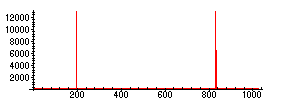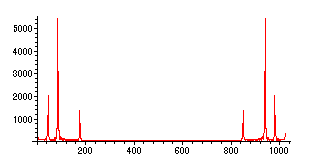
Mathematics 174 -- Applied Mathematics 2
Lab 5 (FFT) Solutions
> restart;
> readlib(FFT):
B) Example 2
> f := x->25*cos(194*x):
> inpR:=array([seq( evalf(f(j*2*Pi/1024)),j=0..1023)]):
> inpI:=array([seq(0,j=0..1024)]):
> FFT(10,inpR,inpI):
> FPSpoints:=[seq([k,sqrt(inpR[k]^2+inpI[k]^2)],k=1..1024)]:
> plot(FPSpoints);

Recall that
in Maple,
the DFT sequence term
![]() gives an approximation to
gives an approximation to
![[Maple Math]](images/AM2Lab5Sol3.gif) , where
, where
![]() is the "analog" Fourier transform of f. If
is the "analog" Fourier transform of f. If
![]() , then this analog FT can be
, then this analog FT can be
obtained like this. The FT of the window function
![]() is similar to that in the worked example,
is similar to that in the worked example,
but the height of the central peak is proportional to the width of the window :
> FW:=int(exp(I*omega*x),x=0..Omega)/(2*Pi):
> assume(omega,real);
> FPS:=abs(subs(Omega=2*Pi,FW)):
> plot(FPS,omega=-20..20,numpoints=300);

The height of the central peak is
![[Maple Math]](images/AM2Lab5Sol8.gif) . By the linearity and modulation properties of the
. By the linearity and modulation properties of the
Fourier Transform, the FT of
![]() looks like two shifted copies of this,
looks like two shifted copies of this,
scaled by 1/2 and superposed (i.e. added) -- centers shifted left and right to -
![]() and +
B.
and +
B.
Going now to the DFT
, recall once again that the DFT sequence term
![]() gives an approximation
gives an approximation
to
![[Maple Math]](images/AM2Lab5Sol12.gif) , where
, where
![]() is the analog FT of
is the analog FT of
![]() . The periodicity of the 1024-point
. The periodicity of the 1024-point
DFT implies that the DFT of
A
cos(
Bx
)
![]() will have peaks at approximately
will have peaks at approximately
![]() and
and
![]() . The height of the peak should be
. The height of the peak should be
![[Maple Math]](images/AM2Lab5Sol18.gif) . For the example above
. For the example above
with
![]() , this gives:
, this gives:
> 512*25;
![]()
which agrees closely with the plot.
D) Using the "mystery signal itself"
> read "/home/fac/little/public_html/Applied9900/mystery.m";
> FFT(10,MystR,MystI):
> FPSpoints:=[seq([k,sqrt(MystR[k]^2+MystI[k]^2)],k=1..1024)]:
> plot(FPSpoints);

Band-pass filter with pass-band: 60 <= |
![]() | <= 120 (MystR and MystI are now the FT of the
| <= 120 (MystR and MystI are now the FT of the
mystery signal.) So in the frequency domain, we want:
> H:=[seq(0,j=1..59),seq(1,j=60..120),seq(0,j=121..903),seq(1,j=904..964),seq(0,j=965..1024)]:
The following is OK for the product
![]() since the imaginary part of H is zero.
since the imaginary part of H is zero.
> FiltR:=array([seq(MystR[k]*H[k],k=1..1024)]):
> FiltI:=array([seq(MystI[k]*H[k],k=1..1024)]):
> iFFT(10,FiltR,FiltI);
![]()
> plot([seq([2*Pi*(j-1)/1024,FiltR[j]],j=100..200)]);

The imaginary part is about 2 orders of magnitude smaller, so we will ignore it.
E) FFT for convolution
> f:=x->exp(-2*(x-3)^2):
> g:=x->exp(-3*(x-2)^2):
> plot({f,g},0..10);

Sampling f and g:
> Ref:=array([seq(evalf(f(10*i/1024)),i=0..1023)]):
> Imf:=array([seq(0,i=0..1023)]):
> Reg:=array([seq(evalf(g(10*i/1024)),i=0..1023)]):
> Img:=array([seq(0,i=0..1023)]):
> FFT(10,Ref,Imf):
> FFT(10,Reg,Img):
Real and imaginary parts of these DFTs are non-zero. Hence to multiply, we must do
the following. (Also, Maple's FFT
does not include our factor
![]() , so the DFT of the
, so the DFT of the
convolution is just the product of the FFTs, without the extra factor of
![]() ):
):
> ReProd:=array([seq(Ref[k]*Reg[k]-Imf[k]*Img[k],k=1..1024)]):
> ImProd:=array([seq(Ref[k]*Img[k]+Imf[k]*Reg[k],k=1..1024)]):
> iFFT(10,ReProd,ImProd):
We want to plot the result on the interval
![]() . So the first coordinates
. So the first coordinates
of the points we plot are
![[Maple Math]](images/AM2Lab5Sol30.gif) . Recall yet again that the DFT sequence term
. Recall yet again that the DFT sequence term
![]() using
using
samples of any function f gives an approximation to
![[Maple Math]](images/AM2Lab5Sol32.gif) , where
, where
![]() is the
is the
analog FT of
![]() . The product of the DFT's gives the
. The product of the DFT's gives the
![]() times the DFT of the
times the DFT of the
convolution -- i.e. our result is
![]() times what we want!! We need to multiply
times what we want!! We need to multiply
by
![]() = 10/1024 to get the correct vertical scaling:
= 10/1024 to get the correct vertical scaling:
> Points:=[seq([10*(i-1)/1024,ReProd[i]*10/1024],i=1..1024)]:
> plot(Points);

Again, the imaginary parts are very small , so we ignore them. By problem II on Problem Set 5
we know a formula for the convolution of
![[Maple Math]](images/AM2Lab5Sol39.gif) and
and
![[Maple Math]](images/AM2Lab5Sol40.gif)
namely:
![]() *
*
![]() =
=
![]() where
where
![[Maple Math]](images/AM2Lab5Sol44.gif) . Our first gaussian is
. Our first gaussian is
![[Maple Math]](images/AM2Lab5Sol45.gif)
(that is,
![[Maple Math]](images/AM2Lab5Sol46.gif) and
c =
2). Similarly, g(
x
) =
and
c =
2). Similarly, g(
x
) =
![[Maple Math]](images/AM2Lab5Sol47.gif) (that is,
(that is,
![[Maple Math]](images/AM2Lab5Sol48.gif) and
and
![]() ).
).
By our formula
f * g =
![[Maple Math]](images/AM2Lab5Sol50.gif) where
where
![[Maple Math]](images/AM2Lab5Sol51.gif) =
=
![[Maple Math]](images/AM2Lab5Sol52.gif) and
c + d =
5 (which agrees with
and
c + d =
5 (which agrees with
the center of the peak in the plot above!)
> plot({Points,(Pi/sqrt(6))*1/sqrt(2*Pi*5/12)*exp(-(x - 5)^2/(2*(5/12)))},x=0..10);

Note: These are so close that it's hard to see that there are two plots here!
>